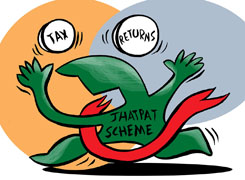Anil Rego |340 Answers |Ask -Follow
Financial Planner - Answered on Jun 03, 2021
He’s an expert in income tax and wealth management.
He has completed his CFA/MBA from the ICFAI Business School.... more

I am an employee of PSU. I have purchased a JEEVAN SHANTI annuity single premium policy from LIFE INSURANCE CORPORATION OF INDIA ON 01/03/2021. Against the premium paid I have applied for tax exemption against LTC cash lump sum policy as announced by GOVERMENT OF INDIA for purchase of any item including insurance policy from the period of OCTOBER till 31/03/2021.
As per what I have read a single premium policy along with GST amount is eligible for tax exemption against LTC cash lump sump benefit. Can you throw some light regarding whether a single premium policy is applicable for getting Tax exemption benefit against LTC cash lump sum policy?
Please note that GST is not charged on the entire premium (GST is charged on 10%of premium for single-premium policies, amounting to 1.8% GST on the entire premium). In this case even though premium attracts 18% GST, the effective claim of GST is only 1.8%.
It was clarified that policies purchased between 12.10.2020 to 31.03.2021 are eligible under the LTC Scheme. So as per this clarification, you can claim this insurance policy for deduction under LTC.
You may like to see similar questions and answers below
Anil Rego |340 Answers |Ask -Follow
Financial Planner - Answered on Jun 08, 2022
Anil Rego |340 Answers |Ask -Follow
Financial Planner - Answered on Feb 04, 2022
Anil Rego |340 Answers |Ask -Follow
Financial Planner - Answered on Aug 29, 2022
Ramalingam Kalirajan |2170 Answers |Ask -Follow
Mutual Funds, Financial Planning Expert - Answered on May 09, 2024
Ravi Mittal |191 Answers |Ask -Follow
Dating, Relationships Expert - Answered on May 14, 2024
Anu Krishna |856 Answers |Ask -Follow
Relationships Expert, Mind Coach - Answered on May 14, 2024
Anu Krishna |856 Answers |Ask -Follow
Relationships Expert, Mind Coach - Answered on May 14, 2024
Ramalingam Kalirajan |2170 Answers |Ask -Follow
Mutual Funds, Financial Planning Expert - Answered on May 14, 2024
Ramalingam Kalirajan |2170 Answers |Ask -Follow
Mutual Funds, Financial Planning Expert - Answered on May 14, 2024
Ramalingam Kalirajan |2170 Answers |Ask -Follow
Mutual Funds, Financial Planning Expert - Answered on May 14, 2024
Anu Krishna |856 Answers |Ask -Follow
Relationships Expert, Mind Coach - Answered on May 14, 2024
Anu Krishna |856 Answers |Ask -Follow
Relationships Expert, Mind Coach - Answered on May 14, 2024
Anu Krishna |856 Answers |Ask -Follow
Relationships Expert, Mind Coach - Answered on May 14, 2024
Ashwini Dasgupta |70 Answers |Ask -Follow
Personality Development Expert, Career Coach - Answered on May 14, 2024














.jpg)









